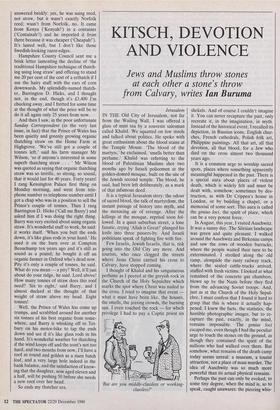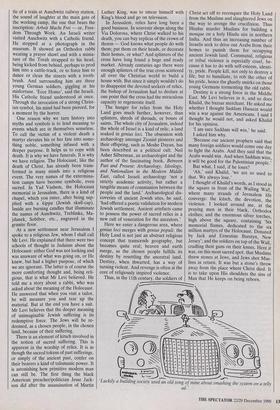KITSCH, DEVOTION AND VIOLENCE
Jews and Muslims throw stones at each other a stone's throw
from Calvary, writes Ian Buruma Jerusalem IN THE Old City of Jerusalem, not far from the Wailing Wall, I was offered a glass of mint tea by a souvenir salesman called Khalid. We squatted on low stools and talked about politics. He spoke with great enthusiasm about the blood stains at the Temple Mount. 'The blood of the martyrs,' he exclaimed, 'smells better than perfume.' Khalid was referring to the blood of Palestinian Muslims shot two months ago by Israeli policemen at the golden-domed mosque, built on the site of the Jewish second temple. The blood, he said, had been left deliberately, as a mark of that infamous deed.
It is a typical Jerusalem story: the odour of sacred blood, the talk of martyrdom, the instant passage of history into myth, and the menacing air of revenge. After the killings at the mosque, reprisal soon fol- lowed. In a quiet suburban street, a lone fanatic, crying 'Allah is Great!' plunged his knife into three passers-by. And Israeli politicians speak of fighting fire with fire.
Few Israelis, Jewish Israelis, that is, risk going into the Old City any more. And tourists, who once clogged the streets where Jesus Christ carried his cross to Calvary, have stopped coming.
I thought of Khalid and his sanguineous perfume as I peered at the greyish rock in the Church of the Holy Sepulchre which marks the spot where Christ was nailed to the cross. I tried to imagine that event what it must have been like, the houses, the smells, the jeering crowds, the burning sun. I even touched the rock — for which privilege I had to pay a Coptic priest six 'But are you middle-classless or working- classless?' shekels. And of course I couldn't imagine it. You can never recapture the past, only recreate it, in the imagination, in myth. Instead of the historical event, I recalled its depiction, in Russian icons, English chur- ches, French cathedrals, Polish folk art, Philippine paintings. All that art, all that devotion, all that blood, for a Jew who died on the cross almost two thousand years ago.
It is a common urge to worship sacred spots, places where something apparently meaningful happened in the past. There is a special aura about places of violent death, which is widely felt and must be dealt with, somehow; sometimes by des- truction, as with Dr Crippen's house in London, or by building a chapel, or a memorial of some sort. This aura is called the genius loci, the spirit of place, which can be a very potent force.
In August, this year, I visited Auschwitz. It was a sunny day. The Silesian landscape was green and quite pleasant. I walked around the Auschwitz and Birkenau camps and saw the rows of wooden barracks, where the people waited their turn to be exterminated. I strolled along the old ramp, alongside the rusty railway track, where the sealed cattle-trucks arrived, stuffed with fresh victims. I looked at what remained of the concrete gas chambers, blown up by the Nazis before they fled from the advancing Soviet troops. And, just as at the Church of the Holy Sepul- chre, I must confess that I found it hard to grasp that this is where it actually hap- pened. I knew the facts, the statistics, the horrible photographic images, but to re- capture the past, exactly, in the mind, remains impossible. The genius loci escaped me, even though I had the peculiar urge to touch the stones on the ground, as though they contained the spirit of the millions who had walked over them. But somehow, what remains of the death camp today seems unreal: a museum, a tourist attraction, not a place of mass murder. The idea of Auschwitz was so much more powerful than its actual physical remains.
Perhaps the past can only be evoked, to some tiny degree, when the mind is, so to speak, caught unawares: the piercing whis- tle of a train at Auschwitz railway station, the sound of laughter at the main gate of the working camp, the one that bears the inscription: Arbeit Macht Frei — or, Free- dom Through Work. An Israeli writer visited Auschwitz with a Catholic friend. He stopped at a photograph in the museum. It showed an Orthodox rabbi wearing a prayer shawl and with a minia- ture of the Torah strapped to his head, being kicked from behind, perhaps to prod him into a cattle-truck, or to force him to dance or clean the streets with a tooth- brush. And surrounding him are three young German soldiers, giggling at his misfortune. `Ecce Homo', said the Israeli. His Catholic friend understood at once. Through the invocation of a strong Christ- ian symbol, his mind had been pierced, for a moment by the horror. One reason why we turn history into myths and symbols is to lend meaning to events which are in themselves senseless. To call the victim of a violent death a martyr elevates his or her fate into some- thing noble, something infused with a deeper purpose. It helps us to cope with death. It is why we have funerals. It is why we have religion. The Holocaust, like the death of Christ, has already been trans- formed in many minds into a religious event. The very names of the extermina- tion camps have become symbolic, even sacred. In Yad Vashem, the Holocaust memorial in Jerusalem, there is a kind of chapel, which you enter, after being sup- plied with a kippa (Jewish skull-cap). Inside are burning candles that illuminate the names of Auschwitz, Treblinka, Ma- jdanek, Sobibor, etc., engraved in the granite floor. At a new settlement near Jerusalem I spoke to a religious Jew, whom I shall call Mr Levi. He explained that there were two schools of thought in Judaism about the Holocaust: either God was not looking and was unaware of what was going on, or He knew, but had a higher purpose, of which we are ignorant. The latter is of course the more comforting thought and, being reli- gious, that is what Mr Levi believed. He told me a story about a rabbi, who was asked about the meaning of the Holocaust. He answered that when you visit a tailor, he will measure you and tear up the material. But at the end you have a suit. Mr Levi believes that the deeper meaning of unimaginable Jewish suffering is its redemptive force. The Jews will be re- deemed, as a chosen people, in the chosen land, because of their suffering.
There is an element of kitsch involved in the notion of sacred suffering. This is apparent in the worship of relics. It is as though the sacred tokens of past sufferings, or simply of the ancient past, confer on their bearers a kind of talismanic power. It is astonishing how primitive modern man can still be. The first thing the black American preacher/politician Jesse Jack- son did after the assassination of Martin Luther King, was to smear himself with King's blood and go on television.
In Jerusalem, relics have long been a good business. In souvenir shops along the Via Dolorosa, where Christ walked to his death, you can buy replicas of the crown of thorns — God knows what people do with them; put them on their heads, or decorate their homes, or what? And splinters of the cross have long found a huge and ready market. Already centuries ago there were enough splinters of the true cross scattered all over the Christian world to build a house with. But since it simply wouldn't do to disappoint the devoted seekers of relics, the bishop of Jerusalem had to declare at one point that the cross had the miraculous capacity to regenerate itself.
The hunger for relics from the Holy Land goes much further, however, than splinters, shreds of shrouds, or bones of saints. The whole city of Jerusalem, indeed the whole of Israel is a kind of relic, a land soaked in genius loci. The obsession with archaeology amongst Zionist pioneers and their offspring, such as Moshe Dayan, has been described as a political cult. Neil Asher Silberman, an archaeologist and the author of the fascinating book, Between Past and Present: Archaeology, Ideology, and Nationalism in the Modern Middle East, called Israeli archaeology 'not a strictly academic activity, but rather a tangible means of communion between the people and the land.' Archaeological dis- coveries of ancient Jewish sites, he said, `had offered a poetic validation for modern Jewish settlement. Ancient artefacts came to possess the power of sacred relics in a new cult of veneration for the ancestors.'
Here we enter a dangerous area, where genius loci merges with genius populi: the Holy Land is not just an abstract religious concept that transcends geography, but becomes quite real; heaven and earth merge, as the chosen people fulfills its destiny by resettling the ancestral land. Destiny, when thwarted, has a way of turning violent. And revenge is often at the core of religiously inspired violence.
Thus, in the 11th century, the soldiers of Christ set off to reconquer the Holy Land from the Muslims and slaughtered Jews on the way to avenge the crucifixion. Thus Hindus murder Muslims for building a mosque on a holy Hindu site in northern India. And thus an increasing number of Israelis seek to drive out Arabs from their homes to punish them for occupying ancient Jewish land. Communal, religious or tribal violence is especially cruel, be- cause it has to do with self-esteem, identi- ty, pride. People kill, not only to destroy a life, but to humiliate, to rob the other of his pride, hence the ghastly smirks on those young Germans tormenting the old rabbi.
Destiny is a strong force in the Middle East. Mr Levi believes in it, and so does Khalid, the bazaar merchant. He asked me whether I thought Saddam Hussein would win a war against the Americans. I said I thought he would not, and asked Khalid for his opinion.
`I am sure Saddam will win,' he said.
I asked him why.
Because our ancient prophets said that many foreign soldiers would come one day to fight the Arabs. And they said that the Arabs would win. And when Saddam wins, it will be good for the Palestinian people.' But what, I said, if he loses?
`Ah,' said Khalid, 'we are so used to that. We always lose.'
I thought of Khalid's words, as I stood in the square in front of the Wailing Wall, where many strands of Jerusalem life converge: the kitsch, the devotion, the violence. I looked around me, at the praying men in their black, Orthodox clothes; and the enormous silver torches, high above the square, containing 'Six memorial flames, dedicated to the six million martyrs of the Holocaust. Donated by Jack and Ernestine Burstyn, New Jersey'; and the soldiers on top of the Wall, cradling their guns on their knees. Here it was, on this most sacred spot, that Muslims threw stones at Jews, and Jews shot Mus- lims in return. It was but a stone's throw away from the place where Christ died. It is to take upon His shoulders the sins of Man that He keeps on being reborn.
`Luckily a building society used an old song of mine about smashing the system on a telly
ad.'



































































































 Previous page
Previous page